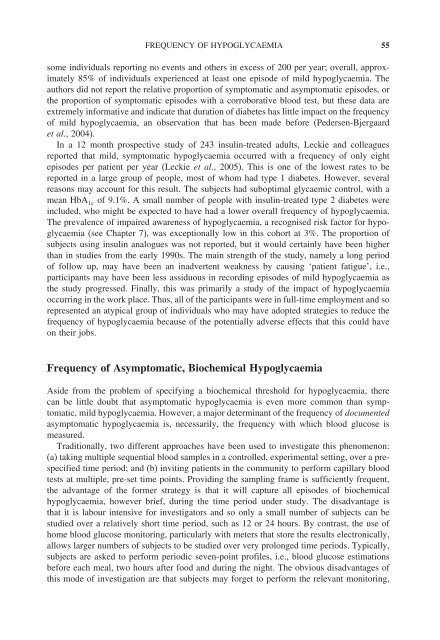Hypoglycaemia in Clinical Diabetes
Hypoglycaemia in Clinical Diabetes
Hypoglycaemia in Clinical Diabetes
- No tags were found...
You also want an ePaper? Increase the reach of your titles
YUMPU automatically turns print PDFs into web optimized ePapers that Google loves.
FREQUENCY OF HYPOGLYCAEMIA 55some <strong>in</strong>dividuals report<strong>in</strong>g no events and others <strong>in</strong> excess of 200 per year; overall, approximately85% of <strong>in</strong>dividuals experienced at least one episode of mild hypoglycaemia. Theauthors did not report the relative proportion of symptomatic and asymptomatic episodes, orthe proportion of symptomatic episodes with a corroborative blood test, but these data areextremely <strong>in</strong>formative and <strong>in</strong>dicate that duration of diabetes has little impact on the frequencyof mild hypoglycaemia, an observation that has been made before (Pedersen-Bjergaardet al., 2004).In a 12 month prospective study of 243 <strong>in</strong>sul<strong>in</strong>-treated adults, Leckie and colleaguesreported that mild, symptomatic hypoglycaemia occurred with a frequency of only eightepisodes per patient per year (Leckie et al., 2005). This is one of the lowest rates to bereported <strong>in</strong> a large group of people, most of whom had type 1 diabetes. However, severalreasons may account for this result. The subjects had suboptimal glycaemic control, with amean HbA 1c of 9.1%. A small number of people with <strong>in</strong>sul<strong>in</strong>-treated type 2 diabetes were<strong>in</strong>cluded, who might be expected to have had a lower overall frequency of hypoglycaemia.The prevalence of impaired awareness of hypoglycaemia, a recognised risk factor for hypoglycaemia(see Chapter 7), was exceptionally low <strong>in</strong> this cohort at 3%. The proportion ofsubjects us<strong>in</strong>g <strong>in</strong>sul<strong>in</strong> analogues was not reported, but it would certa<strong>in</strong>ly have been higherthan <strong>in</strong> studies from the early 1990s. The ma<strong>in</strong> strength of the study, namely a long periodof follow up, may have been an <strong>in</strong>advertent weakness by caus<strong>in</strong>g ‘patient fatigue’, i.e.,participants may have been less assiduous <strong>in</strong> record<strong>in</strong>g episodes of mild hypoglycaemia asthe study progressed. F<strong>in</strong>ally, this was primarily a study of the impact of hypoglycaemiaoccurr<strong>in</strong>g <strong>in</strong> the work place. Thus, all of the participants were <strong>in</strong> full-time employment and sorepresented an atypical group of <strong>in</strong>dividuals who may have adopted strategies to reduce thefrequency of hypoglycaemia because of the potentially adverse effects that this could haveon their jobs.Frequency of Asymptomatic, Biochemical <strong>Hypoglycaemia</strong>Aside from the problem of specify<strong>in</strong>g a biochemical threshold for hypoglycaemia, therecan be little doubt that asymptomatic hypoglycaemia is even more common than symptomatic,mild hypoglycaemia. However, a major determ<strong>in</strong>ant of the frequency of documentedasymptomatic hypoglycaemia is, necessarily, the frequency with which blood glucose ismeasured.Traditionally, two different approaches have been used to <strong>in</strong>vestigate this phenomenon:(a) tak<strong>in</strong>g multiple sequential blood samples <strong>in</strong> a controlled, experimental sett<strong>in</strong>g, over a prespecifiedtime period; and (b) <strong>in</strong>vit<strong>in</strong>g patients <strong>in</strong> the community to perform capillary bloodtests at multiple, pre-set time po<strong>in</strong>ts. Provid<strong>in</strong>g the sampl<strong>in</strong>g frame is sufficiently frequent,the advantage of the former strategy is that it will capture all episodes of biochemicalhypoglycaemia, however brief, dur<strong>in</strong>g the time period under study. The disadvantage isthat it is labour <strong>in</strong>tensive for <strong>in</strong>vestigators and so only a small number of subjects can bestudied over a relatively short time period, such as 12 or 24 hours. By contrast, the use ofhome blood glucose monitor<strong>in</strong>g, particularly with meters that store the results electronically,allows larger numbers of subjects to be studied over very prolonged time periods. Typically,subjects are asked to perform periodic seven-po<strong>in</strong>t profiles, i.e., blood glucose estimationsbefore each meal, two hours after food and dur<strong>in</strong>g the night. The obvious disadvantages ofthis mode of <strong>in</strong>vestigation are that subjects may forget to perform the relevant monitor<strong>in</strong>g,
















